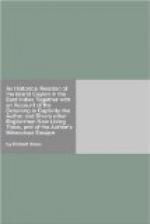[Ants of divers sorts.] There are Ants of several sorts, and some worthy our remark.
First of all, there are the Coumbias, a sort of small reddish Ants like ours in England.
Secondly, the Tale-Coumbias, as small as the former but blackish. These usually live in hollow Trees or rotten Wood, and will sting most terribly.
Thirdly, the Dimbios, great red Ants. These make their nests upon the Boughs of great Trees, bringing the Leaves together in clusters, it may be as big as a mans head; in which they lay their Eggs and breed. There will be oftentimes many nests of these upon one Tree, insomuch that the people are afraid to go up to gather the Fruits lest they should be stung by them.
A fourth sort of Ants are those they call Coura-atch. They are great and black, living in the ground. Their daily practice is to bring up dirt out of the ground, making great hollow holes in the Earth, somewhat resembling Cony-Burrows; onely these are less, and run strait downwards for some way, and then turn away into divers paths under ground. In many places of the Land there are so many of these holes, that Cattle are ready to break their Legs as they go. These do not sting.
A fifth is the Coddia. This Ant is of an excellent bright black, and as large as any of the former. They dwell always in the ground; and their usual practice is, to be travelling in great multitudes, but I do not know where they are going, nor what their business is; but they pass and repass some forwards and some backwards in great hast, seemingly as full of employment as People that pass along the Streets. These Ants will bite desperately, as bad as if a man were burnt with a coal of fire. But they are of a noble nature: for they will not begin; and you may stand by them, if you do not tread upon them nor disturb them. [How these Coddia’s come to sting so terribly.] The reason their bite is thus terribly painful is this; Formerly these Ants went to ask a Wife of the Noya, a venomous and noble kind of Snake; and because they had such an high spirit to dare to offer to be related to such a generous creature, they had this vertue bestowed upon them, that they should sting after this manner. And if they had obtained a Wife of the Noya, they should have had the priviledg to have stung full as bad as he. This is a currant Fable among the Chingulays. Tho undoubtedly they chiefly regard the wisedom that is concealed under this, and the rest of their Fables.
[These Ants a very mischievous sort.] There is a sixth sort called Vaeos. These are more numerous than any of the former. All the whole Earth doth swarm with them. They are of a middle size between the greatest and the least, the hinder part white, and the head red. They eat and devour all that they can come at; as besides food, Cloth, Wood, Thatch of Houses and every thing excepting Iron and Stone. So that the people cannot set any thing upon the ground within their houses for them. They creep up the




